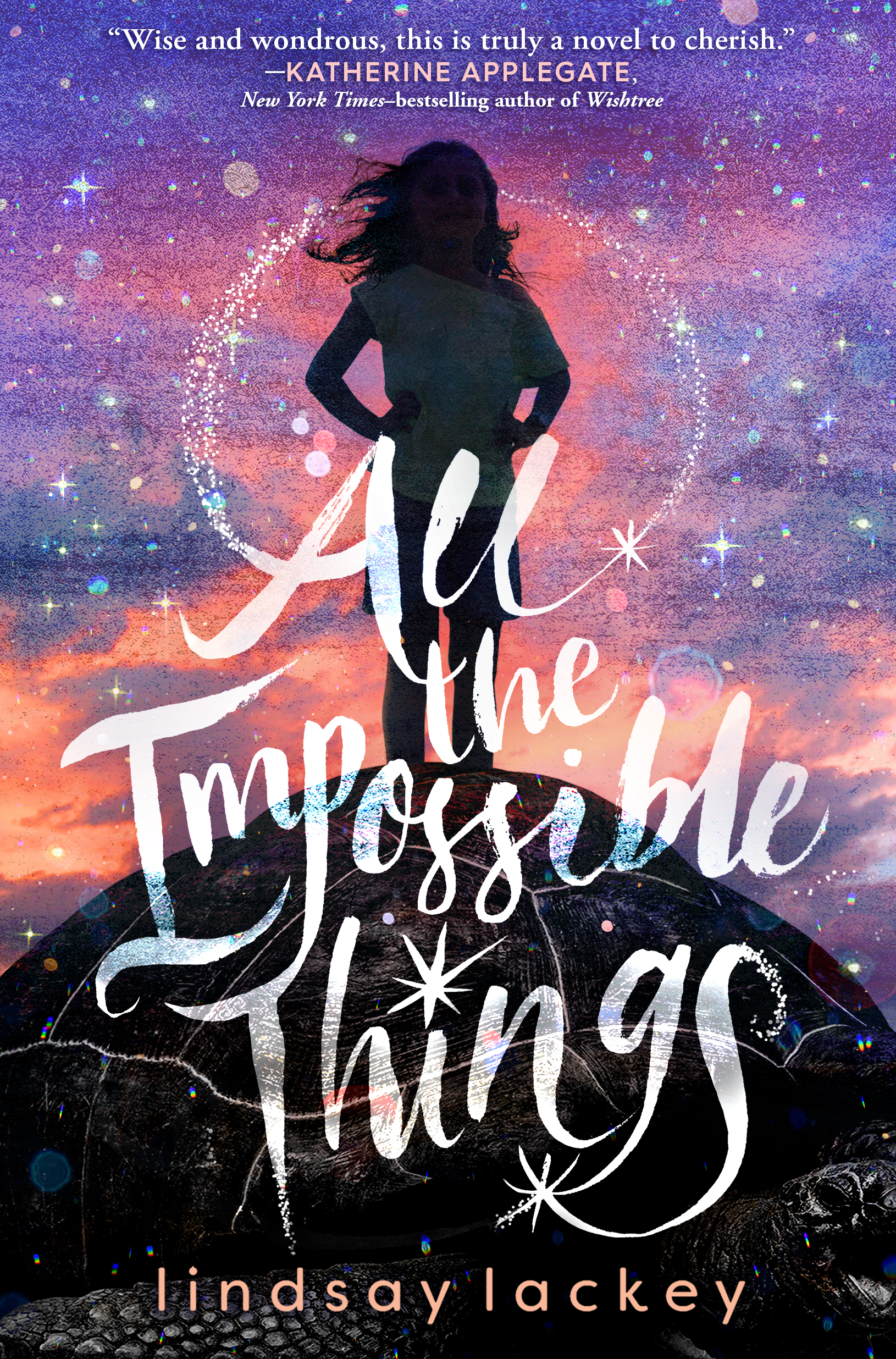One of my favorite middle grade novels of 2019 was Lindsay Lackey’s All the Impossible Things. In her gorgeous debut, Lackey spins a tale about Red, a young girl with an unusual power, who is navigating the foster care system in search of where she belongs. There are many things we could talk about in a craft analysis of this novel–descriptive language, building relatable characters and narrative devices to name a few–but in this post, we’re going to explore how Lackey uses three strategies to seed her novel with tension that grows and climaxes in a truly satisfying reading experience by:
- Emotionally investing her readers in a main character who wants something with huge stakes attached.
- Giving her main character both a strong internal and external conflict.
- Threading her narrative with numerous mysteries that keep readers guessing.
THE STAKES

The strongest novels have main characters who not only want something but want something with serious stakes involved. In All the Impossible Things, Red’s stakes are whether she will ever have a home that truly fits. If she doesn’t, she will never be happy and whole. She will never feel loved. These are stakes that children and adults alike can relate to and will respond to. Readers will keep turning the pages to find out whether Red gets what she wants.
The novel begins with Red leaving a foster care home that doesn’t fit at all. Now she’s going into a new foster home, one that her case worker believes is a good fit, but Red disagrees. She’s convinced that the only home that fits is the one with her mom. But there’s a huge obstacle to that home becoming a reality.
“The Grooves are very kind people,” Ms. Anders said.
Red said nothing.
“You’ll like them.”
Red said nothing.
“They’ll be a good fit. You’ll see.”
A good fit. Impossible. Nobody could be a good fit. Nobody except her mother. Red felt the pulse of the wind in her heart. Three hundred ninety-seven days, she reminded herself. Three hundred ninety-seven days until her mom got out. Three hundred ninety-seven days until Red would be a good fit. (9)
As the story progresses, these stakes are raised. To minimize spoilers, I’ll just say that the stakes are raised by showing the reader the increased complexities of Red’s situation and an escalation of hurdles stopping her from making a home with her mom.
THE CONFLICTS–INTERNAL AND EXTERNAL
Internal Conflict
Red’s internal conflict is the tug and pull between her growing love for her foster family and her deeply held belief that only her mom is the right fit. If she gives up on her deeply held belief, she will be giving up on her mom. If she keeps her deeply held belief, she might never be happy, never feel loved. The reader keeps turning the pages to find out how Red resolves this internal conflict. Does she give up on her mom? Does she reject her foster mom? Or does she find a third solution?
From the start, Red’s new foster mom seems pretty special.
Only Gamma had ever looked at Red the way the lady with sunrise hair was looking at her. It was a look like, You’re here. Like, I see you there. Like, You aren’t too old or quiet or broken at all. (Page 14)
His wife was still smiling at Red. It brought a tickling wind to Red’s skin. She shivered and wrapped her arms around herself. (15)
But for Red, there’s nothing like her bond with her birth mom.
“Ruby.” The woman slipped off the chair and onto her knees, arms out. Like an angel.
The sound of her voice squeezed every ounce of breath from Red’s lungs. Her vision blurred and she clenched her teeth to keep the tears from escaping. She didn’t even feel her feet moving as she crossed the room. Arms lifted. And then she was wrapped around her mother, tight and snug.
“Hello, you,” her mother whispered into Red’s hair. (153)
It’s an impossible situation for Red, this feeling that she’s being asked to choose between the two. But nothing is impossible in this beautiful book.
External Conflict
Red’s external conflict is an actual force of nature. When she gets upset, the wind picks up and storms brew. There’s a building tension throughout the story over how far out of control the wind will become versus whether Red will learn to control it.
“The more she swallowed down her own storms, however, the angrier the sky above her became.” (3)
“She couldn’t let her wind out, no matter how much it boiled beneath her skin.” (5)
“Her storm still thrummed in her bones, whirled between her ribs and toes and ears, as familiar as her own breath. It wanted out, wanted to join the angry sky. She couldn’t let it.” (6)
Again, avoiding spoilers, Red’s “wind” escalates throughout the story as her emotions mount. Readers fly through the pages to discover whether the wind wins or Red does in a battle for control.
MYSTERIOUS THREADS
Lackey introduces a number of mysteries in All the Impossible Things. Here are two that play a large role in keeping the reader engaged. A mystery is a tried and true technique for creating tension that insists on pages turning. But they can’t be inserted just for the sake of a mystery. They are only truly engaging when they are important to the main character’s emotional journey.
The Green Notebook
In Chapter 5, Lackey introduces a green notebook where Red collects impossible things. When she opens it though, it always opens to the same page, and that page holds a mystery, one that keeps readers guessing till the end. This particular mystery is especially compelling because it’s tied to the climax and resolution.
It always opened to the same page. The page covered in tape that held down the shreds of torn paper she’d collected from the bushes and grass and rocks that day at the park.
Gently, she tried to smooth out the collection of ragged papers. Their edges curled up, like they were trying to fly away from the page, but the tape held them fast.
The writing on each of the scraps was a little smeared and faded, but Red didn’t need to see the words to know what they said. She’d read them so many times, she knew every one by heart. There were words missing, of course. A lot of them. Words written on scraps that she hadn’t been able to snag before the wind blew them away.
The holes left by those missing words made the puzzle that much more difficult, but over the years, Red had grown used to their absence. She filled in the gaps a thousand different ways in her own mind, but she knew she couldn’t make everything fit together perfectly. Not yet, anyway.
Not until her mom got out of prison. (30-31)
This mystery compels us throughout the story. It’s a huge part of Red’s inner journey. At the beginning of the novel, we are told that Red’s grandmother said:
“…knowing the difference between hard and impossible is important, baby girl. Lots of things in life are hard. But nothing is impossible.” (36)
We only learn the true importance of these words when we, as readers, finally are let in on the mystery of the green notebook and its torn pieces of paper.
Where’s Tuck?
Arguably, Tuck Everlasting, the tortoise, is the most beloved animal in the petting zoo that Red’s new foster parents run. But on Page 100, he goes missing. Not only does he go missing, but Red thinks it’s her fault.
It’s my fault. Tuck’s gone, and it’s my fault.
She swallowed the lump in her throat. “I want to look for him.” (101)
Readers immediately fall in love with Tuck because he’s so charming, but we also love him because Red loves him. Tuck matters to Red and therefore he matters to us. I dare any reader to stop reading before they know what happens to the missing tortoise. This mystery isn’t just an interesting vignette about a beloved character. It’s a profound metaphor for Red’s own internal conflict. Tuck is a tortoise who already has found a place where he fits. The Groovy Petting Zoo is his home. His disappearance takes on even more emotional depth as Red does everything she can to ensure that he, at least, gets to return to his rightful home.
There are other mysteries as well. Each mystery seeds questions in readers minds and these questions drive page turns. Will Red find Tuck? Why does her foster mom Celine keep rubbing her shoulder uncomfortably? What are the torn pieces of paper in Red’s green notebook? Questions create tension that causes page turns.
If, as Lackey does in All the Impossible Things, you seed your novel with high stakes, internal and external conflict, and numerous mysterious threads, you will have a multitude of possibilities for rising tension and obstacles, and a deeply satisfying climax and resolution.
Actions:
- Make your stakes big and make sure your readers know about them early on.
- Give your main character both an internal and an external conflict.
- Tease up multiple mysteries that enhance the emotional journey of your main character.
If you enjoyed this post, check out last week’s interview of Lindsay Lackey. You might also enjoy digging in to LA Biscay’s two-parter story structure analysis of Erin Entrada Kelly’s Newbery Award Winning HELLO UNIVERSE (Part 1 and Part 2).
Kristi Wright (co-editor) writes picture books and middle grade novels. Her goal as a writer is to give children a sense of wonder, a hopefulness about humanity, and a belief in their future. She is represented by Kurestin Armada at Root Literary. She is an active volunteer for SCBWI and a 12 X 12 member. Find her at www.kristiwrightauthor.com and on Twitter @KristiWrite.


COMMENTs:
0